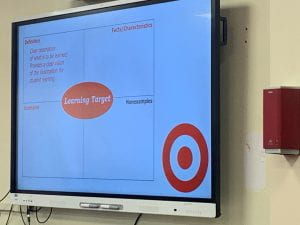Students in South Orangetown have ample opportunities to discuss, debate, and present in classes across K-12 in every subject area. As a part of the New Teacher Workshop Series (Session 3), teacher shared  how the use of discussion protocols is going with their students. Using the application Padlet, a tool also used for collaboration, teachers posted examples of discussion protocols and activities such as the Six Hats Protocol, which was used in a Kindergarten classroom so that every child had an opportunity to speak and share their thoughts. Students could also share their “hat” with other students if they were stuck or needed help speaking. The “Hats” protocol uses different color hats to represent six different perspectives. Another teacher shared that their students enjoyed using the Discussion Mat protocol because they could write down their ideas and then turn the mat to a partner and read it to them. Other protocols enabled students to take on different roles within a small group and to dig deeper into their own thinking while taking peers ideas into consideration. All of the protocols lend themselves to a student-centered classroom where kids are encouraged to speak, debate, and publicly present their ideas and learning in a risk free environment.
how the use of discussion protocols is going with their students. Using the application Padlet, a tool also used for collaboration, teachers posted examples of discussion protocols and activities such as the Six Hats Protocol, which was used in a Kindergarten classroom so that every child had an opportunity to speak and share their thoughts. Students could also share their “hat” with other students if they were stuck or needed help speaking. The “Hats” protocol uses different color hats to represent six different perspectives. Another teacher shared that their students enjoyed using the Discussion Mat protocol because they could write down their ideas and then turn the mat to a partner and read it to them. Other protocols enabled students to take on different roles within a small group and to dig deeper into their own thinking while taking peers ideas into consideration. All of the protocols lend themselves to a student-centered classroom where kids are encouraged to speak, debate, and publicly present their ideas and learning in a risk free environment.
Another goal for these workshops is for everyone to get to know each other regardless of the grade, school, or subject area they teach. Each person shared a meaningful picture from their cell phone and told a story about it. For the next activity, we read and article and watched a video on the role of the student and the teacher in comparison to the role of a Ferry operator or a Bridge Builder (Ref: IDE Corp). Taking a ferry leaves the traveler in the hand of the boat operator and releases the traveler from all responsibility. The operator decides when the boat will leave, how fast it will go, and moves the travelers across the water at the exact same speed. Taking a bridge puts the traveler in control and in the seat of responsibility. Different drivers use different lanes and drive at different speeds. All who start at the bridge do not necessarily end up at the other side at the same time. We strive to support teachers in establishing the structures and strategies necessary to position students to take charge of their own learning by building bridges to get them there.
Dr. Joe Lloyd, Director of Staff Relations, led an activity on establishing clear learning targets to include creating goals with clear descriptions of what is being learned that are measurable and achievable for all students. We then read an article and watched a video on the differences between differentiated practice activities (different sets of math problems for different students to solve) and learning activities (learning centers, interactive websites, videos, articles, discussions), the later being more challenging for teachers to create.
Teachers concluded the day by creating activity lists connected to learning targets for upcoming lessons and units of study. At our next workshop, we will be focusing on formative assessments and data informed instruction. 
